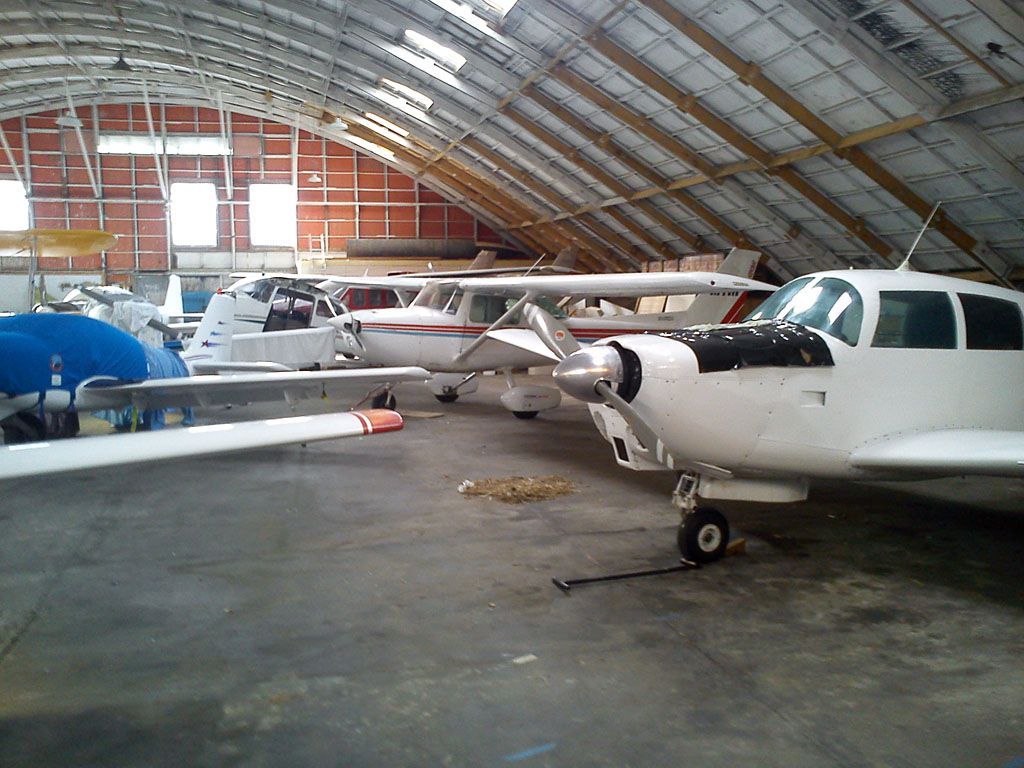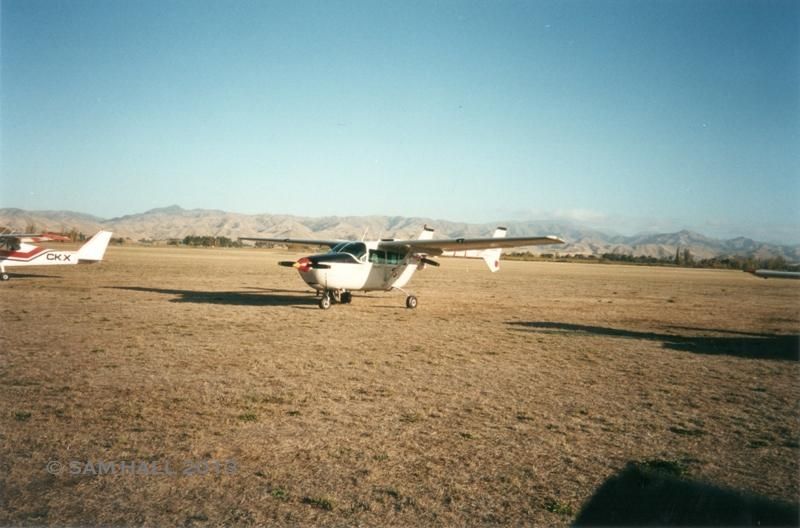|
|
Post by Dave Homewood on Sept 9, 2013 22:18:13 GMT 12
Have any of the push-pull Cessna 337 Skymasters, or military version O-2's, ever operated in New Zealand? The only one I have seen is the O-2 at the Air Force Museum at Wigram.
|
|
|
|
Post by TS on Sept 9, 2013 22:25:27 GMT 12
There used to be one at North Shore Airfield owned by John Verleun for a while . Plus I recall another with the Warbirds I think for a very short while painted in USAF colours. ( if that helps any  ) |
|
|
|
Post by Peter Lewis on Sept 9, 2013 23:35:35 GMT 12
Six 337s.
ZK-DRO DSC KLB all eventually exported to Australia.
ZK-DAQ Destroyed in hangar fire at Rotorua 31Mar81
ZK-TAI Cr Pitt Island, Chathams, 4Dec86
ZK-DFT still registered.
Also one 336
ZK-CGF DBR when cr on t/off at Gisborne 24Apr78
|
|
|
|
Post by Dave Homewood on Sept 9, 2013 23:53:58 GMT 12
Thanks, so there have been a few then.
Has anyone flown in one? Are they noisy? Fast?
|
|
|
|
Post by johnnyfalcon on Sept 10, 2013 7:15:25 GMT 12
The poor man's P-38? People tend to be separated into two camps. Either you love them or hate them. This is most definitely one of the aircraft on my short-list.
Like in most areas of aircraft design certain design advantages sacrifice other pluses. Two engines give the safety advantage in the event of a redundant engine but not twice the speed or range. Push-pull or centre-line-thrust eliminates any adverse yaw in the event of an engine failure but increases cabin noise and minimises baggage space, if you keep all 6 seats. But no engines on the wings means better use of the lifting surfaces and greater visibility. These advantages were the main reasons for the adoption of the 337 into military service.
For a light twin, the 337 has very good range, visibility, reasonable speed (in the order of 170 kts) and good STOL capabilities, especially with the likes of a Robertson kit, the turbocharged/pressurized versions can cruise 200+ kts at altitude and are quieter in the cabin. In my experience though, a good headset makes it much the same as any other light twin.
But, the buying market will always dictate the success or otherwise of a design, no matter how good it may be. If it looks like a duck out of water, or has odd-ball concepts in its design, then history tells us that people won't buy enough to warrant long-term development, no matter what it is. Having two tails, push-pull engines, sounds like a concrete mixer, and no baggage space didn't help. For a production run that lasted some 15 years and nearly 3,000 airframes it showed promise, but not enough for the market.
Anyone want to join me in a syndicate?
|
|
|
|
Post by scrooge on Sept 10, 2013 9:09:31 GMT 12
Nope.
|
|
|
|
Post by Bruce on Sept 10, 2013 9:16:13 GMT 12
There was also VH-ROY which was based out of Ardmore in the early 1990s with Roy Broughton's Hibiscus Air Services (Roy Was later killed in a Nomad Crash on Franz Joseph Glacier). Gulf Aeronautics where I was working looked after the Hibiscus aircraft and I got to fly with Roy in ROY several times. The 337 is a good solid aircraft, A little heavy on the ailerons, but rides turbulence very well. As mentioned it is a bit noisy inside and it really needs the baggage pod as fitted to ROY. Certainly it is good on short strips. As far as maintenance went, working on the rear engine was a pain and it took some serious jacking up for retraction tests, since it needs a lot of space below for the Cessna retracts to swing down.
At one stage Roy, Phil Klaasen (the other pilot in the Nomad Crash) and i flew down to Karioi near Ohakune as part of a trial for an Auckland to Ohakune scheduled service during the ski season. As a regular skier at the time I was roped in to advise on logistics up the mountain. As it happened the weather around the mountain deteriorated and the whole trip turned into quite an adventure, including a low level run through the desert road corridor with visibility right on minimums. Was very glad we were in the good old "truck" rather than the lighter Partenavia that Roy also owned. Good aeroplanes the 337s, once you understand their quirks!
|
|
|
|
Post by scrooge on Sept 10, 2013 9:31:37 GMT 12
Now for an actual contribution to the thread: I flew ZK-KLB for a while from North Shore so my comments relate mainly to that aircraft/model.
It did have good range with full tanks but with full tanks it had no payload. I dont think we ever saw 170kts in straight and level flight, 150 kts rings a bell (though maybe that was due to mostly doing training at lower levels). Unfortunately the only way to get reasonable range and ANY baggage on board was to remove the aft 2 seats (which were also very noisy as they were against the rear cabin/engine bulkhead.
That engine configuration also lead to some special engine handling requirements such as an advisory to taxi and start your take-off by advancing the rear engine first as a number of accidents occured when pilots did not notice the rear engine had cut out at low idle on the taxi and then attempted a takeoff.
An engine failure after takeoff (or any engine failure) required some pre-planning and thought as the rear engine was actually more thrust efficent that the front engine, but the hydralic pump was only on the front engine (I seem to recall).
So if the front engine failed and you feathered it you could climb (sort of) but then not retract the undercarriage. You could leave the front engine windmilling to keep the pump energised but then you would probably be descending and gear retraction would open the gear doors which would result in about a 150 fpm rate of descent (on many aircraft the gear doors were removed to reduce this problem and also save weight and reduce maintenance).
If the rear engine failed, the front engine might allow a slight climb if all went well and you could retract the undercarriage, but would definately be descending during that phase of flight.
Decisions!
|
|
|
|
Post by scrooge on Sept 10, 2013 9:38:45 GMT 12
They also had an interesting fuel system that caught out a few people, in that the engine fuel pumps would draw 50% more fuel than required and return the excess to the main tanks. This meant you had to manage your fuel load/burn so that you burnt enough (or left enough space) from/in the mains before moving to the tips so that there was enough empty tank to take the excess fuel otherwise it was vented overboard and your fuel burn would then become 50% more than planned for a period of time.
|
|
|
|
Post by vs on Sept 10, 2013 11:42:35 GMT 12
I certainly have heard a lot of good things about them. Not to popular with pilots trying to get precious multi time as you have to log it as single engine time due to centre line thrust
|
|
|
|
Post by lumpy on Sept 10, 2013 12:04:02 GMT 12
I certainly have heard a lot of good things about them. Not to popular with pilots trying to get precious multi time as you have to log it as single engine time due to centre line thrust Pretty sure I remember hearing that from a guide at Wigram once . You can fly them on single engine rating ( so I suppose that had some appeal to pilots that didnt have a multi engine rating ) ? |
|
|
|
Post by scrooge on Sept 10, 2013 12:46:56 GMT 12
I certainly have heard a lot of good things about them. Not to popular with pilots trying to get precious multi time as you have to log it as single engine time due to centre line thrust Pretty sure I remember hearing that from a guide at Wigram once . You can fly them on single engine rating ( so I suppose that had some appeal to pilots that didnt have a multi engine rating ) ? Not quite, it is logged as multi engine- has to be, it is. But the time logged can not count toward anything (licence requirement) that 'requires' multi engine time. E.g. to become a multi engine instructor you need 25 hours of multi engine Pilot in Command time, for which centre-line thrust time (and therefore C336/7) does not count. Very confusing until you work that distinction out- took me about 7 years to eventually decipher it. |
|
|
|
Post by FlyingKiwi on Sept 10, 2013 18:48:16 GMT 12
I think you missed one Peter (or might be a re-registration of one you have there) as ZK-FZA (a pressurised Skymaster no less) is currently parked in the Jet Imports hangar at Ardmore. It has a current registration but looks to be in a very un-airworthy state. You can see it in the background here behind what's left of the crashed Ardmore Flying School C-172 ZK-EAT.  |
|
|
|
Post by mumbles on Sept 10, 2013 21:56:00 GMT 12
Plus I recall another with the Warbirds I think for a very short while painted in USAF colours. ( if that helps any  ) This one? Spotted at Woodbourne during the Classic Fighters show in 2001, the only time I recall seeing one. Apologies for the image quality, I'd run out of film for my SLR, so my girlfriend (now wife) took the pic with her point and shoot:  |
|
|
|
Post by Peter Lewis on Sept 10, 2013 22:15:04 GMT 12
There was also VH-ROY which was based out of Ardmore in the early 1990s VH-ROY became ZK-KLB (listed above) |
|
|
|
Post by Peter Lewis on Sept 10, 2013 22:25:28 GMT 12
I think you missed one Peter (or might be a re-registration of one you have there) as ZK-FZA Ah yes, three of those T337G rockets: ZK-TZA Pressurized Super Skymaster - current ZK-THL Pressurised Super Skymaster II - sold as VH-CDQ ZK-TSH Pressurized Super Skymaster II the Chris Amon one - DBR by wind-shear on t/off Waipaua, Pitt Island, Chathams, 6Sep88. Stored Te One, Chathams. Why would you need a pressurized aircraft to fly between Pitt Island and Karewa? |
|
|
|
Post by eieio on Sept 10, 2013 22:30:48 GMT 12
May this year there was several push me pull u at Port Lincoln S A used to spot Tuna I was told
|
|
|
|
Post by craig on Sept 11, 2013 7:16:26 GMT 12
Wasn't there there one based in Timaru some years back
|
|
|
|
Post by Peter Lewis on Sept 11, 2013 9:15:21 GMT 12
ZK-THL was operated by The Helicopter Line/Tourism Holdings from Timaru 1991 thru 1999.
|
|
|
|
Post by Dave Homewood on Sept 11, 2013 9:23:38 GMT 12
Was it in their nice red, white and blue colour scheme?
|
|



